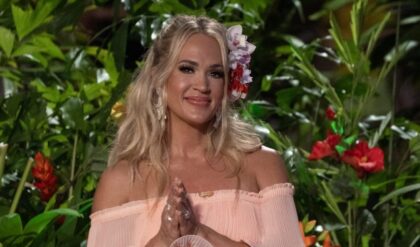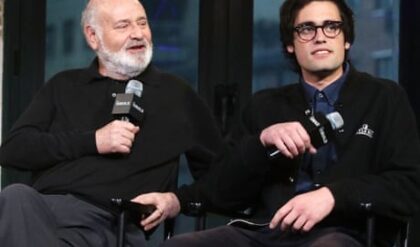From sex-starved pagan gods to top-secret government experimentation, “American Horror Story” has explored just about every corner of American horror mythology in its long run. Spanning several centuries and stretching across the continental United States, the interconnected anthology series imagines a dark, surreal landscape where malevolent demons torment the living, witches wage a silent neverending battle against evil, and the murdered are doomed to spend eternity where they’re slain.
One of the things that makes “American Horror Story” so deliciously moreish is that it’s so much more than just a straightforward horror anthology. It pokes and prods our relationship with the genre, asking viewers to take a closer look at the meaning behind some of the darker themes and tropes that keep us glued to our screens. While the series often explores the world of horror with exactly the right amount of levity and self-awareness, sometimes the recipe misses the mark — particularly when the writers can’t let go of a tired cliché that the audience has had their fill of. Queue up the Stevie Nicks playlist as we take a look at “American Horror Story” tropes fans would happily banish.
Aborted story arcs
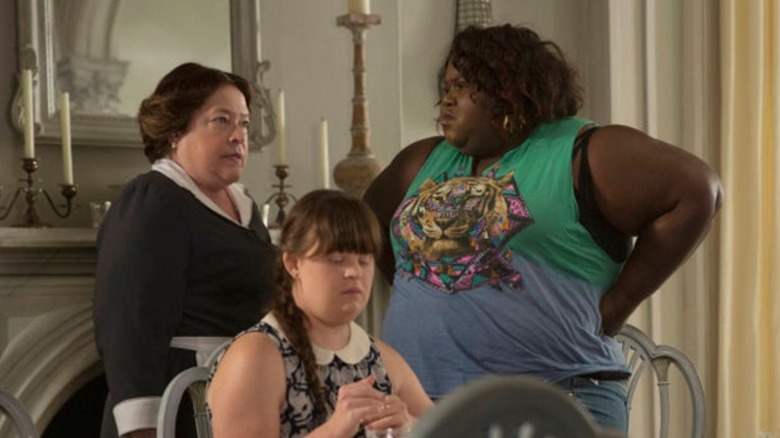
FX
Nothing is more frustrating than getting invested in a character’s journey only to have the writers forget about the whole thing. Either there’s no resolution at all, or the storyline is quickly wrapped up in a way that feels unsatisfying. This problem often plagues shows with bloated ensemble casts and overly ambitious storytelling like “Lost” and “Manifest,” and it’s one of Ryan Murphy’s pet peccadilloes, cropping up often in shows like “Glee” and “American Horror Story.”
With everything from aliens to vampires, “American Horror Story” often feels like a horror-camp variety show with monsters and demons cycling in and out each season. This makes it easier to accept that some in-world alternate timeline shenanigans could be responsible for Richard Ramirez’s (Zach Villa) annual appearance at the Hotel Cortez despite his death-loop imprisonment at Camp Redwood, or overlook Scáthach’s (Lady Gaga) plot fizzling out in “AHS: Roanoke.” However, there are some that are harder for fans to get past.
Despite all of the horrors Delphine inflicted in “AHS: Coven,” thanks to Kathy Bates’ nuanced portrayal and Delphine’s unlikely connection with Queenie (Gabourey Sidibe), the resurrected villain seemed to be on a redemption arc. Queenie and Delphine (Bates) even bonded over drive-through food — forcing the audience to almost forget the depravity of Delphine’s soul — only to see the redemption arc suddenly dropped. Then there’s the aborted human-vampire hybrid baby Bartholomew from “AHS: Hotel,” whose odd nature and unclear fate have spawned many a sub-Reddit rabbit hole.
Waste of a perfectly good character
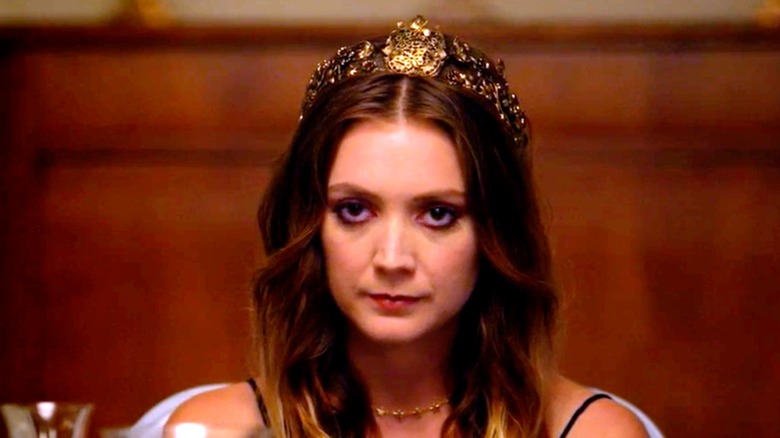
One of the things that makes “American Horror Story” so good is the steady stream of interesting, colorful characters that populate its intersecting timelines and haunted locales. Each season brings a fresh batch of captivating characters, like the fiercely protective but deeply flawed Constance Langdon (Jessica Lange), and the sadistic trickster god Papa Legba (Lance Reddick). It’s one thing to dream up a complex and interesting character, but it’s something entirely different to write stories worthy of them — a problem “American Horror Story” struggles with far too often, according to some fans.
Throat slashing
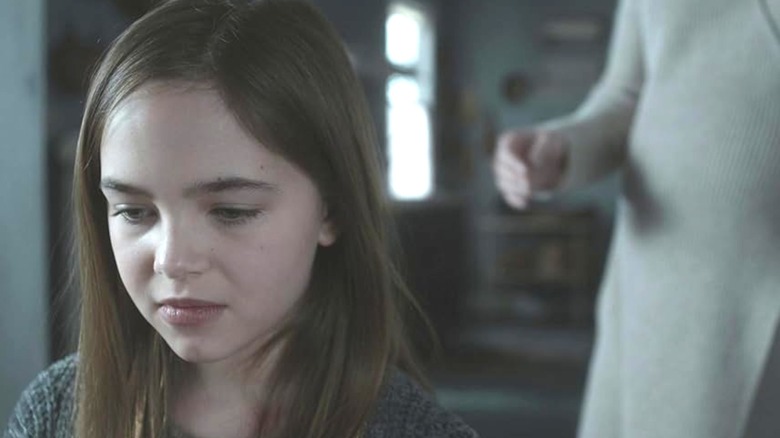
Part of the fun of watching a slasher film is all of the new and interesting ways a monster can take out its latest victims. As an homage to the vast landscape of the horror genre, “American Horror Story” has its share of clever kill scenes, such as the scheming fortune teller Maggie Esmerelda (Emma Roberts) getting her grisly comeuppance at the hands of Chester Creb (Neil Patrick Harris), or Chad Warwick’s (Zachary Quinto) death by apple-bobbing.
While not every death can be a winner in the creativity department, “American Horror Story” fans have noticed the show has a frustrating tendency to rely a little too much on throat slashing. This method packs a lot of punch since it’s quick and gory, and many viewers find throat-slash scenes viscerally disturbing. As Redditor u/BazzaDazza put it, “I can’t physically watch throat slits without feeling nauseous as hell!” Unfortunately, this makes it way too tempting for “American Horror Story” writers to fall back on the trope as a quick-and-dirty gore shortcut. From Violet’s (Taissa Farmiga) dark fantasies in “AHS: Murder House” to Madison Montgomery (Emma Roberts) with a letter opener in “AHS: Coven,” and the parade of trachea-slicings in “AHS: Red Tide,” many fans have expressed annoyance at the ever-growing throat slash tally on the show.
TELEVISION TV DRAMAS
Horror Tropes That American Horror Story Fans Are Sick Of
Static Media/Getty Images/Shutterstock
BY KRISTI ROE-OWEN/OCT. 3, 2023 7:15 AM EST
From sex-starved pagan gods to top-secret government experimentation, “American Horror Story” has explored just about every corner of American horror mythology in its long run. Spanning several centuries and stretching across the continental United States, the interconnected anthology series imagines a dark, surreal landscape where malevolent demons torment the living, witches wage a silent neverending battle against evil, and the murdered are doomed to spend eternity where they’re slain.
One of the things that makes “American Horror Story” so deliciously moreish is that it’s so much more than just a straightforward horror anthology. It pokes and prods our relationship with the genre, asking viewers to take a closer look at the meaning behind some of the darker themes and tropes that keep us glued to our screens. While the series often explores the world of horror with exactly the right amount of levity and self-awareness, sometimes the recipe misses the mark — particularly when the writers can’t let go of a tired cliché that the audience has had their fill of. Queue up the Stevie Nicks playlist as we take a look at “American Horror Story” tropes fans would happily banish.
Aborted story arcs
FX
Nothing is more frustrating than getting invested in a character’s journey only to have the writers forget about the whole thing. Either there’s no resolution at all, or the storyline is quickly wrapped up in a way that feels unsatisfying. This problem often plagues shows with bloated ensemble casts and overly ambitious storytelling like “Lost” and “Manifest,” and it’s one of Ryan Murphy’s pet peccadilloes, cropping up often in shows like “Glee” and “American Horror Story.”
With everything from aliens to vampires, “American Horror Story” often feels like a horror-camp variety show with monsters and demons cycling in and out each season. This makes it easier to accept that some in-world alternate timeline shenanigans could be responsible for Richard Ramirez’s (Zach Villa) annual appearance at the Hotel Cortez despite his death-loop imprisonment at Camp Redwood, or overlook Scáthach’s (Lady Gaga) plot fizzling out in “AHS: Roanoke.” However, there are some that are harder for fans to get past.
Despite all of the horrors Delphine inflicted in “AHS: Coven,” thanks to Kathy Bates’ nuanced portrayal and Delphine’s unlikely connection with Queenie (Gabourey Sidibe), the resurrected villain seemed to be on a redemption arc. Queenie and Delphine (Bates) even bonded over drive-through food — forcing the audience to almost forget the depravity of Delphine’s soul — only to see the redemption arc suddenly dropped. Then there’s the aborted human-vampire hybrid baby Bartholomew from “AHS: Hotel,” whose odd nature and unclear fate have spawned many a sub-Reddit rabbit hole.
Waste of a perfectly good character
FX
One of the things that makes “American Horror Story” so good is the steady stream of interesting, colorful characters that populate its intersecting timelines and haunted locales. Each season brings a fresh batch of captivating characters, like the fiercely protective but deeply flawed Constance Langdon (Jessica Lange), and the sadistic trickster god Papa Legba (Lance Reddick). It’s one thing to dream up a complex and interesting character, but it’s something entirely different to write stories worthy of them — a problem “American Horror Story” struggles with far too often, according to some fans.
One of the most egregious examples of this was with Mallory (Billie Lourd), the powerful witch who was sent into the prophesied apocalypse as a sleeper agent posing as a servant to fellow witch Coco (Leslie Grossman). As her profound hidden abilities begin to resurface, the foundation is laid for an all-out war between good and evil with Mallory serving as a foil to Antichrist Michael Langdon (Cody Fern). Once awakened, Mallory turns out to be crucial to defeating him, but only as a time-turning puzzle piece rather than a supernatural scion capable of standing toe-to-toe with him. As u/The_Firmament put it, “Seeing their stories grow alongside each other until we can feel the confrontation bubbling would’ve been really exciting.” Instead, the Redditor noted, this incredible witch is largely ignored by the writers until the end, when she is disappointingly used as a Deus ex Machina.
Throat slashing
FX
Part of the fun of watching a slasher film is all of the new and interesting ways a monster can take out its latest victims. As an homage to the vast landscape of the horror genre, “American Horror Story” has its share of clever kill scenes, such as the scheming fortune teller Maggie Esmerelda (Emma Roberts) getting her grisly comeuppance at the hands of Chester Creb (Neil Patrick Harris), or Chad Warwick’s (Zachary Quinto) death by apple-bobbing.
While not every death can be a winner in the creativity department, “American Horror Story” fans have noticed the show has a frustrating tendency to rely a little too much on throat slashing. This method packs a lot of punch since it’s quick and gory, and many viewers find throat-slash scenes viscerally disturbing. As Redditor u/BazzaDazza put it, “I can’t physically watch throat slits without feeling nauseous as hell!” Unfortunately, this makes it way too tempting for “American Horror Story” writers to fall back on the trope as a quick-and-dirty gore shortcut. From Violet’s (Taissa Farmiga) dark fantasies in “AHS: Murder House” to Madison Montgomery (Emma Roberts) with a letter opener in “AHS: Coven,” and the parade of trachea-slicings in “AHS: Red Tide,” many fans have expressed annoyance at the ever-growing throat slash tally on the show.
Advertised monsters
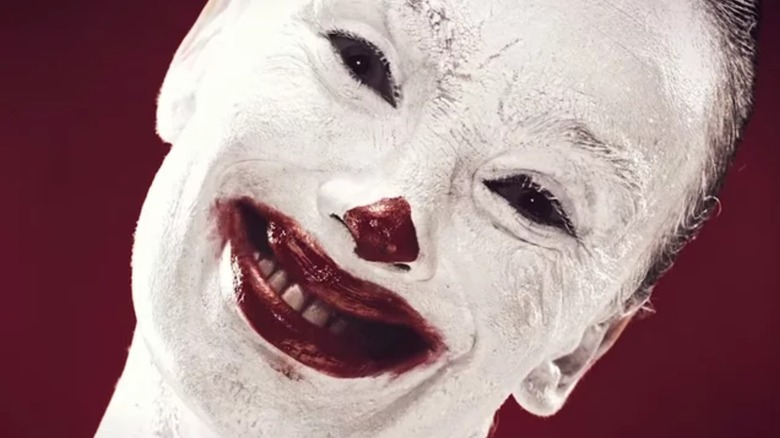
It’s not uncommon for a TV or film trailer to prominently feature a clip that doesn’t make it into the final production. Between its promotional images, teaser trailers, and series intros, “American Horror Story” is one of the worst offenders when it comes to releasing adverts that don’t necessarily have much to do with the series.
Every season has its share of monsters unique to the show’s lore like the Rubber Man of “AHS: Murder House” and the Pale People of “AHS: Red Tide.” However, fans have noticed the show has a tendency to hype up monsters that either don’t live up to their potential or, in some cases, never get the memo that they were due on set. Twisty the Clown (John Carroll Lynch), who featured heavily in the advertising for “AHS: Freak Show” but only appeared in a few episodes, is one of the most prominent examples.
Other monsters that fans felt got short-changed include the twig-winged monster from the “AHS: Coven” and “AHS: Apocalypse” intros and the train track monster misdirect ahead of “AHS: Roanoke.” A few, like the bloodthirsty Infantata of “AHS: Murder House” and the Mattress Man of “AHS: Hotel,” are little more than glorified jump scare generators, while Dr. Arden’s cannibalistic Raspers in “AHS: Asylum,” helped set the eerie tone for the series and then failed to feature meaningfully in the story.
Back from the dead
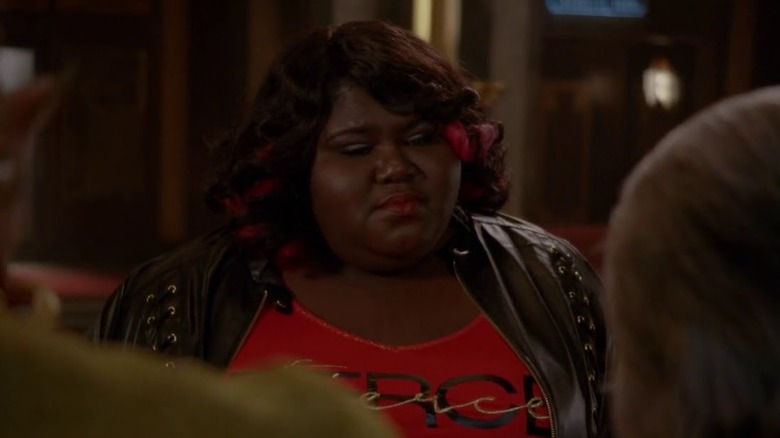
In a world where spirits and magic are part of the mythology, no death is necessarily permanent. In some shows, death is more like a revolving door, and if a character sticks around long enough, there’s a good chance they’ll eventually get resurrected at least once. The unfortunate side effect of this is that it tends to deflate some of the impact when a beloved main character suddenly dies. As Redditor u/cherryncoke observed, “If they don’t stay dead, there’s no impact, and it becomes impossible to care that someone has died.”
On the flip side, there’s always a chance we’ll get to see some of our favorites again even when they’ve met an untimely demise. Take Queenie, the human voodoo doll who had the misfortune of dying on several occasions. First, she’s gored to death by a minotaur in the show’s most instantly regrettable hookup. She is resurrected by fading Supreme Fiona Goode (Jessica Lange) but makes the tragic mistake of booking a room at the Hotel Cortez, where she gets killed by a joint effort from James March (Evan Peters) and Ramona Royale (Angela Bassett), with Michael Langdon finally springing her from the undead realm only to have Miriam Mead (Kathy Bates) kill her again. This time, it seems her soul is destroyed for good — that is, until Mallory’s alternate timeline magic kicks in, undoing her death and restoring Queenie to the witch we know and love.
Luke, I am your father
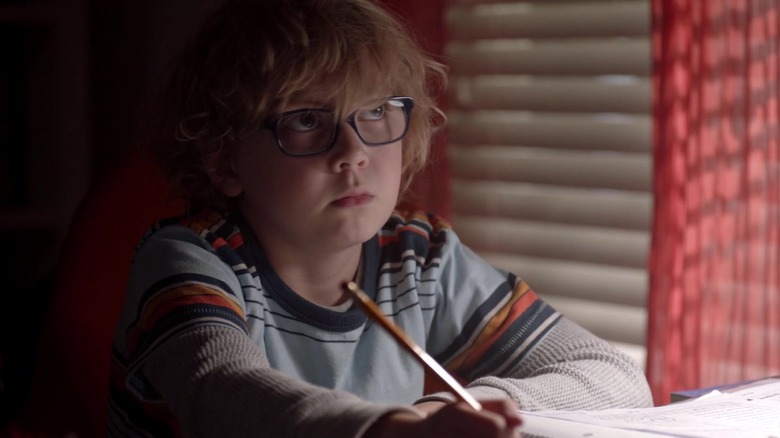
When it comes to cheesy drama tropes, it doesn’t get much soapier than the unexpected paternity reveal, especially when the DNA test results are just downright ridiculous. Not only are these relative reveals distracting, but they can also be pretty confusing. In the world of “American Horror Story,” this trope is used more generally to reveal unexpected family connections in several seasons.
One of the most prominent examples extends a minor plot from “AHS: Murder House” into the primary storyline of “AHS: Apocalypse,” eventually revealing the charismatic demon spawn Michael to be the child of Vivien Harmon (Connie Britton) and the Satan-infused ghost of Tate Langdon (Evan Peters). While some fans simply took this tangled mess with a grain of salt, many found themselves puzzling over the details, with some concluding the house was Michael’s real father. Reddit user u/centerstage80 wryly observed, “He is fathered by the holy trinity, Ryan Murphy, Tom Hanks and The Fonz from Happy Days.”
The trope is reversed when Lana (Sarah Paulson) is confronted with her son Johnny Morgan (Dylan McDermott), the product of her rape by original Bloody Face Oliver Thredson (Zachary Quinto), and when Ms. Mead is revealed to be a replica of the woman who raised Michael. It’s a storyline that gets particularly convoluted in “AHS: Cult” when Kai (Evan Peters) is convinced he’s Ozymandias’ (Cooper Dodson) dad, a belief Ally (Paulson) is later content to exploit in her efforts to take the cult leader down.
TELEVISION TV DRAMAS
Horror Tropes That American Horror Story Fans Are Sick Of
Static Media/Getty Images/Shutterstock
BY KRISTI ROE-OWEN/OCT. 3, 2023 7:15 AM EST
From sex-starved pagan gods to top-secret government experimentation, “American Horror Story” has explored just about every corner of American horror mythology in its long run. Spanning several centuries and stretching across the continental United States, the interconnected anthology series imagines a dark, surreal landscape where malevolent demons torment the living, witches wage a silent neverending battle against evil, and the murdered are doomed to spend eternity where they’re slain.
One of the things that makes “American Horror Story” so deliciously moreish is that it’s so much more than just a straightforward horror anthology. It pokes and prods our relationship with the genre, asking viewers to take a closer look at the meaning behind some of the darker themes and tropes that keep us glued to our screens. While the series often explores the world of horror with exactly the right amount of levity and self-awareness, sometimes the recipe misses the mark — particularly when the writers can’t let go of a tired cliché that the audience has had their fill of. Queue up the Stevie Nicks playlist as we take a look at “American Horror Story” tropes fans would happily banish.
Aborted story arcs
FX
Nothing is more frustrating than getting invested in a character’s journey only to have the writers forget about the whole thing. Either there’s no resolution at all, or the storyline is quickly wrapped up in a way that feels unsatisfying. This problem often plagues shows with bloated ensemble casts and overly ambitious storytelling like “Lost” and “Manifest,” and it’s one of Ryan Murphy’s pet peccadilloes, cropping up often in shows like “Glee” and “American Horror Story.”
With everything from aliens to vampires, “American Horror Story” often feels like a horror-camp variety show with monsters and demons cycling in and out each season. This makes it easier to accept that some in-world alternate timeline shenanigans could be responsible for Richard Ramirez’s (Zach Villa) annual appearance at the Hotel Cortez despite his death-loop imprisonment at Camp Redwood, or overlook Scáthach’s (Lady Gaga) plot fizzling out in “AHS: Roanoke.” However, there are some that are harder for fans to get past.
Despite all of the horrors Delphine inflicted in “AHS: Coven,” thanks to Kathy Bates’ nuanced portrayal and Delphine’s unlikely connection with Queenie (Gabourey Sidibe), the resurrected villain seemed to be on a redemption arc. Queenie and Delphine (Bates) even bonded over drive-through food — forcing the audience to almost forget the depravity of Delphine’s soul — only to see the redemption arc suddenly dropped. Then there’s the aborted human-vampire hybrid baby Bartholomew from “AHS: Hotel,” whose odd nature and unclear fate have spawned many a sub-Reddit rabbit hole.
Waste of a perfectly good character
FX
One of the things that makes “American Horror Story” so good is the steady stream of interesting, colorful characters that populate its intersecting timelines and haunted locales. Each season brings a fresh batch of captivating characters, like the fiercely protective but deeply flawed Constance Langdon (Jessica Lange), and the sadistic trickster god Papa Legba (Lance Reddick). It’s one thing to dream up a complex and interesting character, but it’s something entirely different to write stories worthy of them — a problem “American Horror Story” struggles with far too often, according to some fans.
One of the most egregious examples of this was with Mallory (Billie Lourd), the powerful witch who was sent into the prophesied apocalypse as a sleeper agent posing as a servant to fellow witch Coco (Leslie Grossman). As her profound hidden abilities begin to resurface, the foundation is laid for an all-out war between good and evil with Mallory serving as a foil to Antichrist Michael Langdon (Cody Fern). Once awakened, Mallory turns out to be crucial to defeating him, but only as a time-turning puzzle piece rather than a supernatural scion capable of standing toe-to-toe with him. As u/The_Firmament put it, “Seeing their stories grow alongside each other until we can feel the confrontation bubbling would’ve been really exciting.” Instead, the Redditor noted, this incredible witch is largely ignored by the writers until the end, when she is disappointingly used as a Deus ex Machina.
Throat slashing
FX
Part of the fun of watching a slasher film is all of the new and interesting ways a monster can take out its latest victims. As an homage to the vast landscape of the horror genre, “American Horror Story” has its share of clever kill scenes, such as the scheming fortune teller Maggie Esmerelda (Emma Roberts) getting her grisly comeuppance at the hands of Chester Creb (Neil Patrick Harris), or Chad Warwick’s (Zachary Quinto) death by apple-bobbing.
While not every death can be a winner in the creativity department, “American Horror Story” fans have noticed the show has a frustrating tendency to rely a little too much on throat slashing. This method packs a lot of punch since it’s quick and gory, and many viewers find throat-slash scenes viscerally disturbing. As Redditor u/BazzaDazza put it, “I can’t physically watch throat slits without feeling nauseous as hell!” Unfortunately, this makes it way too tempting for “American Horror Story” writers to fall back on the trope as a quick-and-dirty gore shortcut. From Violet’s (Taissa Farmiga) dark fantasies in “AHS: Murder House” to Madison Montgomery (Emma Roberts) with a letter opener in “AHS: Coven,” and the parade of trachea-slicings in “AHS: Red Tide,” many fans have expressed annoyance at the ever-growing throat slash tally on the show.
Advertised monsters
FX
It’s not uncommon for a TV or film trailer to prominently feature a clip that doesn’t make it into the final production. Between its promotional images, teaser trailers, and series intros, “American Horror Story” is one of the worst offenders when it comes to releasing adverts that don’t necessarily have much to do with the series.
Every season has its share of monsters unique to the show’s lore like the Rubber Man of “AHS: Murder House” and the Pale People of “AHS: Red Tide.” However, fans have noticed the show has a tendency to hype up monsters that either don’t live up to their potential or, in some cases, never get the memo that they were due on set. Twisty the Clown (John Carroll Lynch), who featured heavily in the advertising for “AHS: Freak Show” but only appeared in a few episodes, is one of the most prominent examples.
Other monsters that fans felt got short-changed include the twig-winged monster from the “AHS: Coven” and “AHS: Apocalypse” intros and the train track monster misdirect ahead of “AHS: Roanoke.” A few, like the bloodthirsty Infantata of “AHS: Murder House” and the Mattress Man of “AHS: Hotel,” are little more than glorified jump scare generators, while Dr. Arden’s cannibalistic Raspers in “AHS: Asylum,” helped set the eerie tone for the series and then failed to feature meaningfully in the story.
Back from the dead
FX
In a world where spirits and magic are part of the mythology, no death is necessarily permanent. In some shows, death is more like a revolving door, and if a character sticks around long enough, there’s a good chance they’ll eventually get resurrected at least once. The unfortunate side effect of this is that it tends to deflate some of the impact when a beloved main character suddenly dies. As Redditor u/cherryncoke observed, “If they don’t stay dead, there’s no impact, and it becomes impossible to care that someone has died.”
On the flip side, there’s always a chance we’ll get to see some of our favorites again even when they’ve met an untimely demise. Take Queenie, the human voodoo doll who had the misfortune of dying on several occasions. First, she’s gored to death by a minotaur in the show’s most instantly regrettable hookup. She is resurrected by fading Supreme Fiona Goode (Jessica Lange) but makes the tragic mistake of booking a room at the Hotel Cortez, where she gets killed by a joint effort from James March (Evan Peters) and Ramona Royale (Angela Bassett), with Michael Langdon finally springing her from the undead realm only to have Miriam Mead (Kathy Bates) kill her again. This time, it seems her soul is destroyed for good — that is, until Mallory’s alternate timeline magic kicks in, undoing her death and restoring Queenie to the witch we know and love.
Luke, I am your father
FX
When it comes to cheesy drama tropes, it doesn’t get much soapier than the unexpected paternity reveal, especially when the DNA test results are just downright ridiculous. Not only are these relative reveals distracting, but they can also be pretty confusing. In the world of “American Horror Story,” this trope is used more generally to reveal unexpected family connections in several seasons.
One of the most prominent examples extends a minor plot from “AHS: Murder House” into the primary storyline of “AHS: Apocalypse,” eventually revealing the charismatic demon spawn Michael to be the child of Vivien Harmon (Connie Britton) and the Satan-infused ghost of Tate Langdon (Evan Peters). While some fans simply took this tangled mess with a grain of salt, many found themselves puzzling over the details, with some concluding the house was Michael’s real father. Reddit user u/centerstage80 wryly observed, “He is fathered by the holy trinity, Ryan Murphy, Tom Hanks and The Fonz from Happy Days.”
The trope is reversed when Lana (Sarah Paulson) is confronted with her son Johnny Morgan (Dylan McDermott), the product of her rape by original Bloody Face Oliver Thredson (Zachary Quinto), and when Ms. Mead is revealed to be a replica of the woman who raised Michael. It’s a storyline that gets particularly convoluted in “AHS: Cult” when Kai (Evan Peters) is convinced he’s Ozymandias’ (Cooper Dodson) dad, a belief Ally (Paulson) is later content to exploit in her efforts to take the cult leader down.
Gratuitous sexual assault
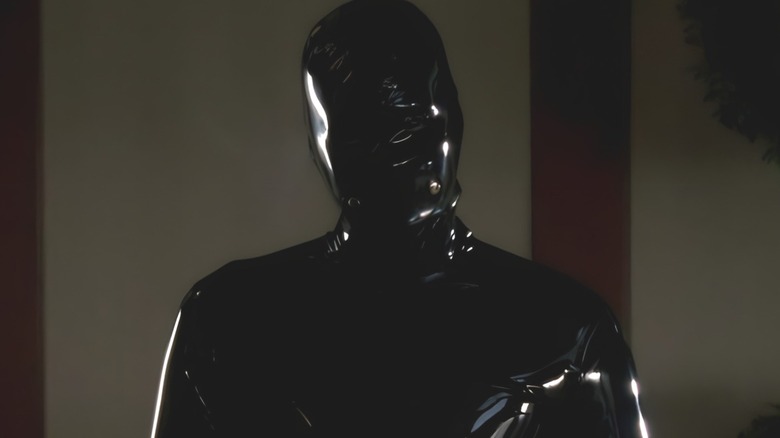
As a show that makes a habit of delving into the more depraved side of human nature, “American Horror Story” has never shied away from rape and sexual abuse. But after a few seasons, it’s hard not to notice the sheer volume of sexual violence used in the series — so much so that some fans have expressed concern for what it says about the showrunner. Far too often, it’s a type of horror that seems to exist in the narrative primarily for shock value. For anyone with a sexual abuse trauma trigger, the show is a minefield. Reddit user u/Cyancat123 warned, “This show is littered with too many rape scenes to count … you’ll definitely want to skip Hotel as the certain kind of rape in that one is AWFUL.”
While a few may arguably support the storytelling — like Tate’s rape of Vivien to create the Antichrist (“AHS: Murder House”) or Madison’s gang rape (“AHS: Coven”) — some are downright horrific like the Addiction Demon from “AHS: Hotel.” For many fans of the show, sexual violence serves as a lazy horror shortcut. There’s also a general sense that the show is better when it’s exploring more psychological horrors like obsession or marital discord. As u/karmander put it, “Horror is the genre to explore rape and sexual assault, but it must be done in a way that doesn’t rely on harmful tropes. It also can’t be overused.”
Super cool serial killers
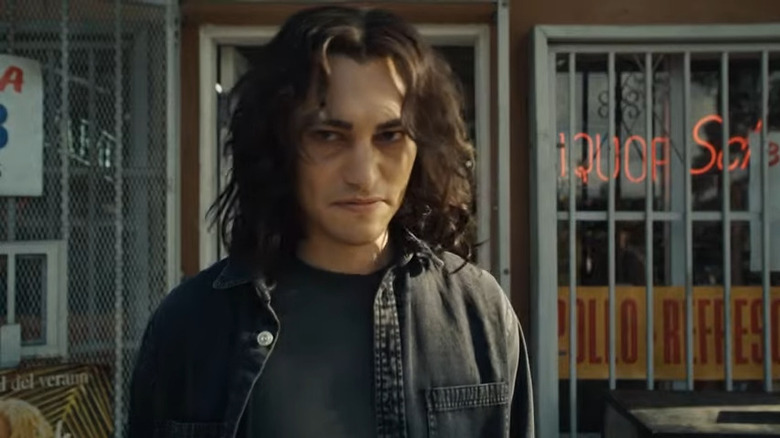
Given the prevalence of murder, torture, and general gore in the horror genre, getting overly sensitive over the portrayal of villains might seem a bit like splitting hairs. In theory, it’s hard to understand how a real-world serial killer is that much worse than a fictional Nazi eugenicist or the psychopathic architect-turned-serial killer who transforms his hotel into a labyrinth of horrors. Since Ryan Murphy seems determined to leave no taboo unturned in the “American Horror Story” universe, real true crime stories surface in the series, particularly through the show’s portrayal of serial killers like John Wayne Gacy, Jeffrey Dahmer, Richard Ramirez, Delphine LaLaurie, and Aileen Wuornos and mass-murdering cult leaders like Charles Manson, Marshall Applewhite, and Jim Jones. In practice, bringing these characters into the campy world of “American Horror Story” can come off as insensitive and distasteful.
The problem comes down to the tone of the series. As a tongue-in-cheek horror show, everything “AHS” does is infused with snark, which makes it hard to create stories that are sensitive to victims’ experiences. Worse, even the vilest villains tend to be unavoidably charming when “Murphyfied.” As u/zombiessalad observed, “1984” elevated Ramirez’s character, giving the real serial killer “the exact kind of ‘legendary tale’ he would dream of.” Reflecting the sentiment, u/bryangball emphasized, “Glorifying real life serial killers is always gross.”
Everyone looks familiar
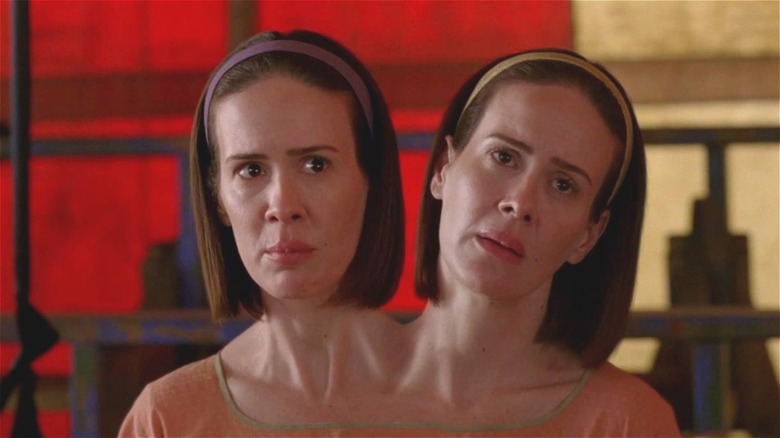
A quirk of “American Horror Story” is the way the show reuses cast members in new roles. The result is that over the course of the show’s run, many different characters pop up who bear eerie resemblances to others in the “AHS” universe. It isn’t a problem for most fans — as Redditor u/Daigonik noted, it’s the same suspension of disbelief we experience when seeing a theatrical production: “You just accept it and roll with it.” It’s also nice to have some fresh faces join the team from time to time, especially when they include the likes of Cody Fern and Billie Lourd. It also helps the show avoid what many fans think is one of its worst habits: overreliance on Evan Peters and Sarah Paulson.
Both Peters and Paulson have appeared on most “AHS” seasons, in some cases stepping into multiple roles. By the time she appeared on “AHS: Roanoke,” even Paulson was suffering from Paulson fatigue. After appearing on “American Crime Story,” Paulson told The Hollywood Reporter’s Awards Chatter podcast she felt “really kind of trapped by my responsibility and my contractual obligation to do American Horror Story,” a problem that was resolved by her return for “AHS: Cult” and “AHS: Apocalypse.” Fans appreciated the break too, a sentiment u/Colsephur echoed when observing, “I’m finding a season without them as leads pretty refreshing … I think the show needed to significantly shake up the cast to make it feel less repetitive.”
Sassy and angry Black women
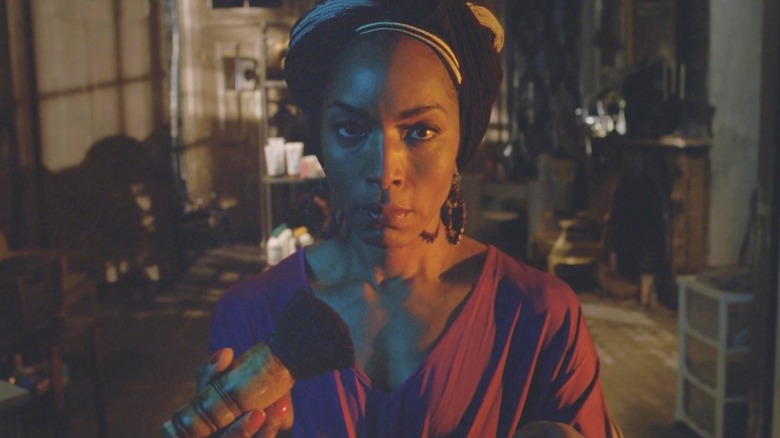
The small screen offers no shortage of tiring and generally offensive racial tropes. There’s the eternally wise Magical Negro serving up an endless stream of homespun wisdom and spiritual guidance or perennially maternal Mammy figure. One that “American Horror Story” just can’t seem to get enough of is the Angry or Sassy Black Woman despite fans’ insistence that the show could do a much better job of portraying complex and nuanced women of color.
In her TIME editorial “Black Women Are Not ‘Sassy’ — We’re Angry,” Brittney Cooper defines the trope as “caricatures of finger-waving, eye-rolling black women at whom everyone loves to laugh,” a stereotype Cooper says tends to “put white folks at ease.” In the world of “American Horror Story,” the trope is so prevalent some fans feel it telegraphs the writers’ failure to see women of color as complex, multi-faceted individuals. For these fans, it’s especially frustrating to see such lazy writing wasted on gems like Angela Bassett. As Redditor u/grumblebuzz opined, “The characters Ryan Murphy has written for her have been such one-dimensional caricatures of Black women” rather than “a real fleshed-out character.” Others found it irksome that Black women in “AHS” often seem driven by a need for revenge like Ramona Royale’s obsession with the Countess (“AHS: Hotel”), Marie Laveau’s thirst for revenge against the witches (“AHS: Coven”), and Beverly Holt’s (Adina Porter) searing rage in “AHS: Cult.”
Unnecessary love triangles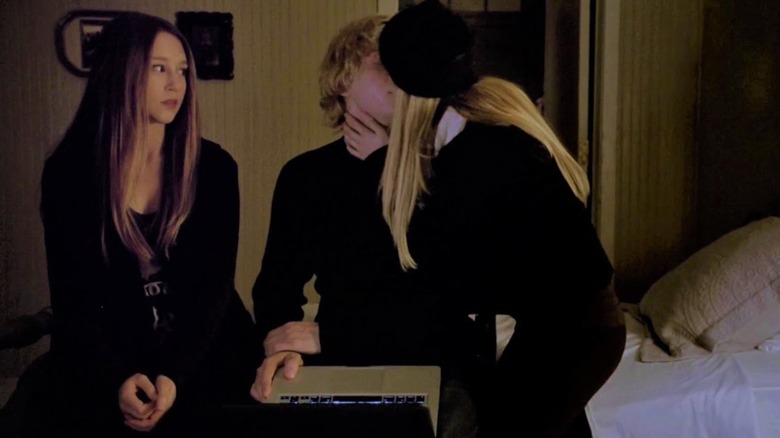
Like everything in the Murphyverse, “American Horror Story” doesn’t fit neatly into any genre. While there’s plenty of gore and psychological horror, it often feels like the drama surrounding the characters is more essential to the storytelling than anything else. To that end, the series has a tendency to get a little soapy. While fans mostly enjoy its storytelling, their tolerance for writers’ reliance on seemingly gratuitous love triangles in the show is starting to wear a little thin, particularly when it comes to Evan Peters.
Maybe it’s typecasting, but if the longtime “AHS” favorite shows up, it’s usually only a matter of time before viewers are crossing off “Evan Peters love triangle” from their “American Horror Story” bingo cards. There’s Kit’s polygamous romance with Alma (Britne Oldford) and Grace (Lizzie Brocheré) in “AHS: Asylum,” Jimmy Darling’s marriage to Bette and Dot (both played by Sarah Paulson) in “AHS: Freak Show,” and whatever James March has going on with Hazel and the Countess (“AHS: Hotel”). And that’s to say nothing of the cringe-inducing threesome between Madison, Zoe (Taissa Farmiga), and the childlike resurrected Kyle (also played by Peters) in “AHS: Coven.” As one Redditor lamented, the storyline “degenerated into a simplistic love triangle with grunting, dumb Kyle running off and canoodling with Zoe for the rest of the season.” It’s not just Peters who suffers from this overplayed trope. Even the heavily hyped steamy Gaga-Bomer-Wittrock triangle of “AHS: Hotel” left some fans feeling fling fatigue.
TELEVISION TV DRAMAS
Horror Tropes That American Horror Story Fans Are Sick Of
Static Media/Getty Images/Shutterstock
BY KRISTI ROE-OWEN/OCT. 3, 2023 7:15 AM EST
From sex-starved pagan gods to top-secret government experimentation, “American Horror Story” has explored just about every corner of American horror mythology in its long run. Spanning several centuries and stretching across the continental United States, the interconnected anthology series imagines a dark, surreal landscape where malevolent demons torment the living, witches wage a silent neverending battle against evil, and the murdered are doomed to spend eternity where they’re slain.
One of the things that makes “American Horror Story” so deliciously moreish is that it’s so much more than just a straightforward horror anthology. It pokes and prods our relationship with the genre, asking viewers to take a closer look at the meaning behind some of the darker themes and tropes that keep us glued to our screens. While the series often explores the world of horror with exactly the right amount of levity and self-awareness, sometimes the recipe misses the mark — particularly when the writers can’t let go of a tired cliché that the audience has had their fill of. Queue up the Stevie Nicks playlist as we take a look at “American Horror Story” tropes fans would happily banish.
Aborted story arcs
FX
Nothing is more frustrating than getting invested in a character’s journey only to have the writers forget about the whole thing. Either there’s no resolution at all, or the storyline is quickly wrapped up in a way that feels unsatisfying. This problem often plagues shows with bloated ensemble casts and overly ambitious storytelling like “Lost” and “Manifest,” and it’s one of Ryan Murphy’s pet peccadilloes, cropping up often in shows like “Glee” and “American Horror Story.”
With everything from aliens to vampires, “American Horror Story” often feels like a horror-camp variety show with monsters and demons cycling in and out each season. This makes it easier to accept that some in-world alternate timeline shenanigans could be responsible for Richard Ramirez’s (Zach Villa) annual appearance at the Hotel Cortez despite his death-loop imprisonment at Camp Redwood, or overlook Scáthach’s (Lady Gaga) plot fizzling out in “AHS: Roanoke.” However, there are some that are harder for fans to get past.
Despite all of the horrors Delphine inflicted in “AHS: Coven,” thanks to Kathy Bates’ nuanced portrayal and Delphine’s unlikely connection with Queenie (Gabourey Sidibe), the resurrected villain seemed to be on a redemption arc. Queenie and Delphine (Bates) even bonded over drive-through food — forcing the audience to almost forget the depravity of Delphine’s soul — only to see the redemption arc suddenly dropped. Then there’s the aborted human-vampire hybrid baby Bartholomew from “AHS: Hotel,” whose odd nature and unclear fate have spawned many a sub-Reddit rabbit hole.
Waste of a perfectly good character
FX
One of the things that makes “American Horror Story” so good is the steady stream of interesting, colorful characters that populate its intersecting timelines and haunted locales. Each season brings a fresh batch of captivating characters, like the fiercely protective but deeply flawed Constance Langdon (Jessica Lange), and the sadistic trickster god Papa Legba (Lance Reddick). It’s one thing to dream up a complex and interesting character, but it’s something entirely different to write stories worthy of them — a problem “American Horror Story” struggles with far too often, according to some fans.
One of the most egregious examples of this was with Mallory (Billie Lourd), the powerful witch who was sent into the prophesied apocalypse as a sleeper agent posing as a servant to fellow witch Coco (Leslie Grossman). As her profound hidden abilities begin to resurface, the foundation is laid for an all-out war between good and evil with Mallory serving as a foil to Antichrist Michael Langdon (Cody Fern). Once awakened, Mallory turns out to be crucial to defeating him, but only as a time-turning puzzle piece rather than a supernatural scion capable of standing toe-to-toe with him. As u/The_Firmament put it, “Seeing their stories grow alongside each other until we can feel the confrontation bubbling would’ve been really exciting.” Instead, the Redditor noted, this incredible witch is largely ignored by the writers until the end, when she is disappointingly used as a Deus ex Machina.
Throat slashing
FX
Part of the fun of watching a slasher film is all of the new and interesting ways a monster can take out its latest victims. As an homage to the vast landscape of the horror genre, “American Horror Story” has its share of clever kill scenes, such as the scheming fortune teller Maggie Esmerelda (Emma Roberts) getting her grisly comeuppance at the hands of Chester Creb (Neil Patrick Harris), or Chad Warwick’s (Zachary Quinto) death by apple-bobbing.
While not every death can be a winner in the creativity department, “American Horror Story” fans have noticed the show has a frustrating tendency to rely a little too much on throat slashing. This method packs a lot of punch since it’s quick and gory, and many viewers find throat-slash scenes viscerally disturbing. As Redditor u/BazzaDazza put it, “I can’t physically watch throat slits without feeling nauseous as hell!” Unfortunately, this makes it way too tempting for “American Horror Story” writers to fall back on the trope as a quick-and-dirty gore shortcut. From Violet’s (Taissa Farmiga) dark fantasies in “AHS: Murder House” to Madison Montgomery (Emma Roberts) with a letter opener in “AHS: Coven,” and the parade of trachea-slicings in “AHS: Red Tide,” many fans have expressed annoyance at the ever-growing throat slash tally on the show.
Advertised monsters
FX
It’s not uncommon for a TV or film trailer to prominently feature a clip that doesn’t make it into the final production. Between its promotional images, teaser trailers, and series intros, “American Horror Story” is one of the worst offenders when it comes to releasing adverts that don’t necessarily have much to do with the series.
Every season has its share of monsters unique to the show’s lore like the Rubber Man of “AHS: Murder House” and the Pale People of “AHS: Red Tide.” However, fans have noticed the show has a tendency to hype up monsters that either don’t live up to their potential or, in some cases, never get the memo that they were due on set. Twisty the Clown (John Carroll Lynch), who featured heavily in the advertising for “AHS: Freak Show” but only appeared in a few episodes, is one of the most prominent examples.
Other monsters that fans felt got short-changed include the twig-winged monster from the “AHS: Coven” and “AHS: Apocalypse” intros and the train track monster misdirect ahead of “AHS: Roanoke.” A few, like the bloodthirsty Infantata of “AHS: Murder House” and the Mattress Man of “AHS: Hotel,” are little more than glorified jump scare generators, while Dr. Arden’s cannibalistic Raspers in “AHS: Asylum,” helped set the eerie tone for the series and then failed to feature meaningfully in the story.
Back from the dead
FX
In a world where spirits and magic are part of the mythology, no death is necessarily permanent. In some shows, death is more like a revolving door, and if a character sticks around long enough, there’s a good chance they’ll eventually get resurrected at least once. The unfortunate side effect of this is that it tends to deflate some of the impact when a beloved main character suddenly dies. As Redditor u/cherryncoke observed, “If they don’t stay dead, there’s no impact, and it becomes impossible to care that someone has died.”
On the flip side, there’s always a chance we’ll get to see some of our favorites again even when they’ve met an untimely demise. Take Queenie, the human voodoo doll who had the misfortune of dying on several occasions. First, she’s gored to death by a minotaur in the show’s most instantly regrettable hookup. She is resurrected by fading Supreme Fiona Goode (Jessica Lange) but makes the tragic mistake of booking a room at the Hotel Cortez, where she gets killed by a joint effort from James March (Evan Peters) and Ramona Royale (Angela Bassett), with Michael Langdon finally springing her from the undead realm only to have Miriam Mead (Kathy Bates) kill her again. This time, it seems her soul is destroyed for good — that is, until Mallory’s alternate timeline magic kicks in, undoing her death and restoring Queenie to the witch we know and love.
Luke, I am your father
FX
When it comes to cheesy drama tropes, it doesn’t get much soapier than the unexpected paternity reveal, especially when the DNA test results are just downright ridiculous. Not only are these relative reveals distracting, but they can also be pretty confusing. In the world of “American Horror Story,” this trope is used more generally to reveal unexpected family connections in several seasons.
One of the most prominent examples extends a minor plot from “AHS: Murder House” into the primary storyline of “AHS: Apocalypse,” eventually revealing the charismatic demon spawn Michael to be the child of Vivien Harmon (Connie Britton) and the Satan-infused ghost of Tate Langdon (Evan Peters). While some fans simply took this tangled mess with a grain of salt, many found themselves puzzling over the details, with some concluding the house was Michael’s real father. Reddit user u/centerstage80 wryly observed, “He is fathered by the holy trinity, Ryan Murphy, Tom Hanks and The Fonz from Happy Days.”
The trope is reversed when Lana (Sarah Paulson) is confronted with her son Johnny Morgan (Dylan McDermott), the product of her rape by original Bloody Face Oliver Thredson (Zachary Quinto), and when Ms. Mead is revealed to be a replica of the woman who raised Michael. It’s a storyline that gets particularly convoluted in “AHS: Cult” when Kai (Evan Peters) is convinced he’s Ozymandias’ (Cooper Dodson) dad, a belief Ally (Paulson) is later content to exploit in her efforts to take the cult leader down.
Gratuitous sexual assault
FX
As a show that makes a habit of delving into the more depraved side of human nature, “American Horror Story” has never shied away from rape and sexual abuse. But after a few seasons, it’s hard not to notice the sheer volume of sexual violence used in the series — so much so that some fans have expressed concern for what it says about the showrunner. Far too often, it’s a type of horror that seems to exist in the narrative primarily for shock value. For anyone with a sexual abuse trauma trigger, the show is a minefield. Reddit user u/Cyancat123 warned, “This show is littered with too many rape scenes to count … you’ll definitely want to skip Hotel as the certain kind of rape in that one is AWFUL.”
While a few may arguably support the storytelling — like Tate’s rape of Vivien to create the Antichrist (“AHS: Murder House”) or Madison’s gang rape (“AHS: Coven”) — some are downright horrific like the Addiction Demon from “AHS: Hotel.” For many fans of the show, sexual violence serves as a lazy horror shortcut. There’s also a general sense that the show is better when it’s exploring more psychological horrors like obsession or marital discord. As u/karmander put it, “Horror is the genre to explore rape and sexual assault, but it must be done in a way that doesn’t rely on harmful tropes. It also can’t be overused.”
If you or anyone you know has been a victim of sexual assault, help is available. Visit the Rape, Abuse & Incest National Network website or contact RAINN’s National Helpline at 1-800-656-HOPE (4673).
Super cool serial killers
FX/YouTube
Given the prevalence of murder, torture, and general gore in the horror genre, getting overly sensitive over the portrayal of villains might seem a bit like splitting hairs. In theory, it’s hard to understand how a real-world serial killer is that much worse than a fictional Nazi eugenicist or the psychopathic architect-turned-serial killer who transforms his hotel into a labyrinth of horrors. Since Ryan Murphy seems determined to leave no taboo unturned in the “American Horror Story” universe, real true crime stories surface in the series, particularly through the show’s portrayal of serial killers like John Wayne Gacy, Jeffrey Dahmer, Richard Ramirez, Delphine LaLaurie, and Aileen Wuornos and mass-murdering cult leaders like Charles Manson, Marshall Applewhite, and Jim Jones. In practice, bringing these characters into the campy world of “American Horror Story” can come off as insensitive and distasteful.
The problem comes down to the tone of the series. As a tongue-in-cheek horror show, everything “AHS” does is infused with snark, which makes it hard to create stories that are sensitive to victims’ experiences. Worse, even the vilest villains tend to be unavoidably charming when “Murphyfied.” As u/zombiessalad observed, “1984” elevated Ramirez’s character, giving the real serial killer “the exact kind of ‘legendary tale’ he would dream of.” Reflecting the sentiment, u/bryangball emphasized, “Glorifying real life serial killers is always gross.”
Everyone looks familiar
FX
A quirk of “American Horror Story” is the way the show reuses cast members in new roles. The result is that over the course of the show’s run, many different characters pop up who bear eerie resemblances to others in the “AHS” universe. It isn’t a problem for most fans — as Redditor u/Daigonik noted, it’s the same suspension of disbelief we experience when seeing a theatrical production: “You just accept it and roll with it.” It’s also nice to have some fresh faces join the team from time to time, especially when they include the likes of Cody Fern and Billie Lourd. It also helps the show avoid what many fans think is one of its worst habits: overreliance on Evan Peters and Sarah Paulson.
Both Peters and Paulson have appeared on most “AHS” seasons, in some cases stepping into multiple roles. By the time she appeared on “AHS: Roanoke,” even Paulson was suffering from Paulson fatigue. After appearing on “American Crime Story,” Paulson told The Hollywood Reporter’s Awards Chatter podcast she felt “really kind of trapped by my responsibility and my contractual obligation to do American Horror Story,” a problem that was resolved by her return for “AHS: Cult” and “AHS: Apocalypse.” Fans appreciated the break too, a sentiment u/Colsephur echoed when observing, “I’m finding a season without them as leads pretty refreshing … I think the show needed to significantly shake up the cast to make it feel less repetitive.”
Sassy and angry Black women
FX
The small screen offers no shortage of tiring and generally offensive racial tropes. There’s the eternally wise Magical Negro serving up an endless stream of homespun wisdom and spiritual guidance or perennially maternal Mammy figure. One that “American Horror Story” just can’t seem to get enough of is the Angry or Sassy Black Woman despite fans’ insistence that the show could do a much better job of portraying complex and nuanced women of color.
In her TIME editorial “Black Women Are Not ‘Sassy’ — We’re Angry,” Brittney Cooper defines the trope as “caricatures of finger-waving, eye-rolling black women at whom everyone loves to laugh,” a stereotype Cooper says tends to “put white folks at ease.” In the world of “American Horror Story,” the trope is so prevalent some fans feel it telegraphs the writers’ failure to see women of color as complex, multi-faceted individuals. For these fans, it’s especially frustrating to see such lazy writing wasted on gems like Angela Bassett. As Redditor u/grumblebuzz opined, “The characters Ryan Murphy has written for her have been such one-dimensional caricatures of Black women” rather than “a real fleshed-out character.” Others found it irksome that Black women in “AHS” often seem driven by a need for revenge like Ramona Royale’s obsession with the Countess (“AHS: Hotel”), Marie Laveau’s thirst for revenge against the witches (“AHS: Coven”), and Beverly Holt’s (Adina Porter) searing rage in “AHS: Cult.”
Unnecessary love triangles
FX
Like everything in the Murphyverse, “American Horror Story” doesn’t fit neatly into any genre. While there’s plenty of gore and psychological horror, it often feels like the drama surrounding the characters is more essential to the storytelling than anything else. To that end, the series has a tendency to get a little soapy. While fans mostly enjoy its storytelling, their tolerance for writers’ reliance on seemingly gratuitous love triangles in the show is starting to wear a little thin, particularly when it comes to Evan Peters.
Maybe it’s typecasting, but if the longtime “AHS” favorite shows up, it’s usually only a matter of time before viewers are crossing off “Evan Peters love triangle” from their “American Horror Story” bingo cards. There’s Kit’s polygamous romance with Alma (Britne Oldford) and Grace (Lizzie Brocheré) in “AHS: Asylum,” Jimmy Darling’s marriage to Bette and Dot (both played by Sarah Paulson) in “AHS: Freak Show,” and whatever James March has going on with Hazel and the Countess (“AHS: Hotel”). And that’s to say nothing of the cringe-inducing threesome between Madison, Zoe (Taissa Farmiga), and the childlike resurrected Kyle (also played by Peters) in “AHS: Coven.” As one Redditor lamented, the storyline “degenerated into a simplistic love triangle with grunting, dumb Kyle running off and canoodling with Zoe for the rest of the season.” It’s not just Peters who suffers from this overplayed trope. Even the heavily hyped steamy Gaga-Bomer-Wittrock triangle of “AHS: Hotel” left some fans feeling fling fatigue.
Culturally religious characters
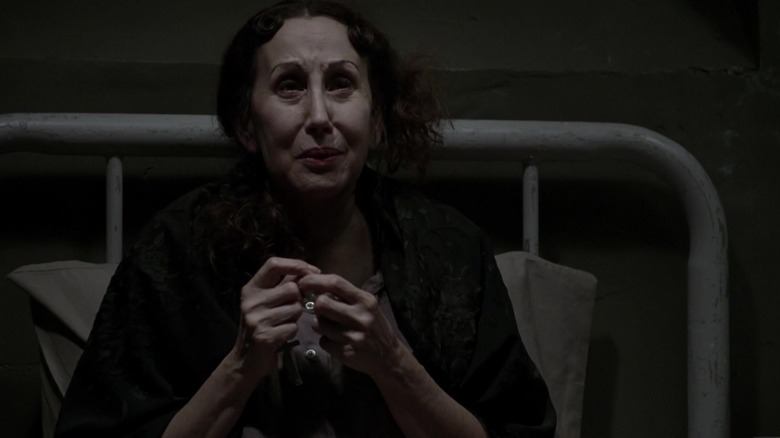
Another horror trope that fans could use less of is superstitiously religious Latinx characters. It’s a trope often found both inside and outside of the horror genre that portrays Latinx folks as almost fanatical Catholics. As Redditor u/salaminokamel noted, “Either it’s a gang member who only loves his abuela and Jesus or it’s a poor single mother type who lives with her mamá and also loves Jesus.” And far too often, u/jvp180 adds, these rosary-clutching devout serve as supernatural radar detectors who “instantly know when evil is afoot and instead of explaining or being rational they lapse into frantic Spanish and freak out the white people.”
The trope first shows up in “AHS: Asylum” in Gloria Laino’s portrayal of a nameless character credited only as “The Mexican” (sigh). Despite apparently speaking no English, this poor woman and her rosary have found themselves locked up in Briarcliff Manor. When the possessed Sister Mary Eunice (Lily Rabe) visits her, the sobbing woman mutters frantically in Spanish, “Go away, Satan!” before begging the demon to spare her life in vain. Laino’s too-brief performance is one of the best in the season, making it that much worse to see her wasted on a weak cliché. The stereotype popped up again in the spin-off anthology series “American Horror Stories” by way of a Spanish-speaking nanny.
